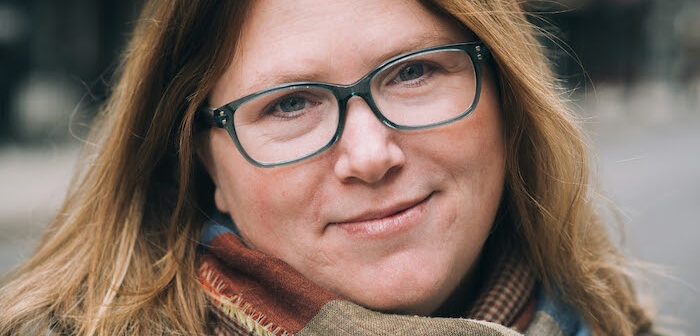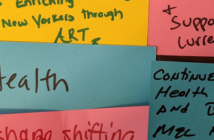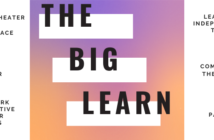Randi was recently featured in the A.R.T./New York donor newsletter. We thought this information about IndieSpace and Indie Theater Fund’s work might be interesting for our indie theater community as well.
We thank A.R.T./New York for the opportunity to share. Please visit their website and learn more about their resources, funding, and/or membership.
Randi’s interview was recorded and transcribed. We made some minor edits for clarity.
~~~~~~~~~~~
My introduction to arts service was as an artist that needed service. And that introduction to service has influenced all the work that I’m doing now as the executive director of IndieSpace and The Indie Theater Fund. Every single decision that we make as an organization is led by the needs that I experienced and that my collaborators were experiencing when trying to put work together in New York City.
The origin of the Fund actually came from a speech that Judith Malina and Brad Burgess of The Living Theater gave over a decade ago about revenue sharing in major league sports. The larger teams that were more profitable would contribute a larger percentage of their revenue to the teams in the smaller markets, so that there was a competitive field to play against and with.
And so the idea for the Fund was birthed: larger institutions might contribute a very small percentage of their income in order to support the entire ecosystem of indie theater makers in New York City. The League of Independent Theater – where I was serving as a board member at the time – is where the work began. We wrote down everything that wasn’t working in philanthropy for indie artists and small-budget organizations and tried to create something that would flip every single one of those principles on their heads.
The Indie Theater Fund became its own organization from there and started addressing those obstacles; long lead times between application and award, bias in the paneling process and the lack of transparency, long applications that were incredibly onerous for organizations that didn’t have resources or development staff to write an application that was competitive. We experimented with what our shape would look like as an institution in the context of a global recession. That’s the seed from which the responsive nature of our work has grown.
At the beginning of 2016, we started to do the same type of work, but from the real estate perspective, and IndieSpace was established. Creating theater in a real estate market like New York is incredibly difficult for both itinerant artists and those attempting to operate space sustainably. IndieSpace has a free advisory and consulting program for artists facing a real estate transition, challenge, or opportunity. We have a goal to right the relationship between artists and their real estate and create PERMANENT spaces. We aim to correct systemic inequities that have kept certain groups of people, specifically Black, Indigenous, and People of Color, from operating and owning space.
Responding to the moment, in the moment
Theaters in New York closed on March 12, 2020. We got our first grant out to artists and theater makers on March 13. The next day. And the reason that we were able to do that is because of all the work that happened in the ten years before. We are deeply rooted in our community and understood many people were going to be forgotten by the larger system, and that they would be without food and rent money within a week to two weeks of missed pay. We had an emergency fund already in place and decided to give smaller grants to larger groups of people to try to get as much money out the door as possible, to as many people as possible. We were able to do that with our very simple application and process. After some iterating and changing, we realized ‘first come, first serve’ wasn’t going to work for this emergency. Everyone was in a crisis at the same time. We had to pause, rethink, and refocus on our priorities to ensure that those most deeply impacted were reached.
Even though ‘indie theater’ is all creators marginalized within the larger theater ecosystem, artists of color are way further marginalized than their white counterparts. So we started experimenting with what it would look like to prioritize those historically excluded in our emergency applications. We were already doing this in our annual applications, but emergencies were typically only granted on an as-needed basis. We take feedback from our members incredibly seriously. We do multiple surveys each year, and all of our programs and offerings have come from those responses because we should be a reflection of the community that we’re serving. We’ve been working with a weighted lottery and keep trying to iterate. We have people self-identify, and those who identify as one of our priority groups (the Global Majority artists, immigrant artists, disabled artists, trans, nonbinary, and gender expansive artists) get a heavier weight in our lottery process.
I credit Kyoung Park and Raquel Almazan, who worked side by side with me throughout the Rapid Relief Emergency Grant process and steered much of the change in the decision-making. And, of course, our board, who were incredibly supportive of the changes every step of the way. We pushed all the priority groups to the top of the list and granted them the full $500 available per artist. We got to everybody! We were able to fund every single application that came in – over 600 artists.
Going Forward
COVID didn’t change our priorities all that much; it changed our capacity to serve our community. Our two orgs are merging, to fall under IndieSpace’s name. I think this will give us the bandwidth to focus on big ideas. COVID highlighted the lack of a safety net available for the workers and artists in our field. We are thinking ‘big picture’ about wraparound support and care: how does the person show up to the work, and how can that person be healthy. That means they have mental health care. That means they have an affordable place to do their work. That means they’re not as worried constantly about food scarcity and having to juggle multiple jobs.
We also learned more about coalition-building between service organizations during the last two years. There was amazing, amazing work that happened with the Cultural Solidarity Fund. We administered the Fund, with leadership by Leimay. Seventeen institutions came together as organizers, but hundreds of institutions contributed $500 or $1,000 in order to support 1850 grants, so far (I really want to give a grant to every last applicant in this process as well – 384 to go). The City Artists Corps – Fourteen service organizations work together as communication partners and TA partners. And there was an incredible brain trust of people that came together to support the field that have dedicated their lives to this work, including A.R.T./New York, the Indie Theater Fund, Dance NYC, Black Public Media, Asian American Arts Alliance, and many others.
And that’s what we’re focused on. We’re thinking a lot about a safety net. That is, a partnership between service organizations and city artists and funders where we come together and figure out ‘what does disaster preparedness look like?’ But beyond that, what does it look like when we work together? It’s rare that we’re not in the middle of an emergency these days. But what would it look like if we were working together in collaboration, transparency, and support so that we were ready in between those emergencies and supporting the field in a more robust way? Because we can do more if we do it together. During these times that we’re fortifying ourselves, that we’re feeding ourselves, we need to work on consistent mental health care, think through portable benefits packages, about 401k and retirement. That’s what I’m interested in.
Were there problems in these coalitions? Of course, there are problems. There will always be problems, it’s not going to work, and then you try again. These are practical solutions. They’re about resource sharing. They’re about labor sharing. There is never only one good idea. We all have really good ideas. We’ve all been working really hard. We’ve all had various experiences, ideas, roadblocks, and obstacles. We’re stronger when we figure it out together. There is so much to do. We need to dedicate funds for historically excluded artists – we need big time, piles of money. We need to give land back to Indigenous artists. These are big ideas that must happen. They will not happen unless we work together. But I have never seen it more possible than right now.




